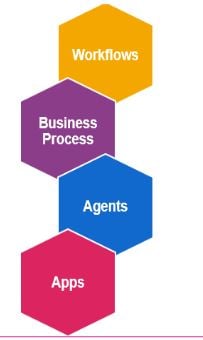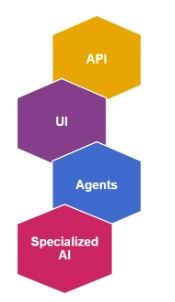UiPath as a rapid application development platform

Introduction
As we look forward to the immense promise of AI, agentic automation, and the benefits it brings to a developer’s day-to-day life, there is still much to be said about traditional development models. Those models have evolved over the years and are now a standard tool for most teams. In my daily life as VP of a very busy product management team building the core of the UiPath Platform, I often find myself exploring how it supports both the philosophy and the application of the Rapid Application Development (RAD) approach.
What is RAD?
If you’re new to RAD, let’s spend a minute explaining the concept. If you're already familiar with RAD, or you run a RAD team, don't worry. The primer is short, and we'll talk about the main question in just a few lines.
RAD is an approach to application development that is agile, user-focused, iterative, productive, and collaborative. With rapid application development, developers can quickly make multiple iterations and updates to the software without starting from scratch. This helps ensure that the outcome is more quality-focused, and aligns with the end users’ requirements.

And if your team is already using RAD for faster results, you are not alone. The global RAD platform market size was estimated at USD $41.77 billion in 2023 and is expected to grow at a compound annual growth rate (CAGR) of 41.8% from 2024 to 2030. This trend is driven by increasing demand for faster software delivery, a quicker ROI, and faster time to market.
Why developer teams need RAD
In the fast-paced markets of today, development teams and companies are pressured to deliver quick solutions. Traditional development methods often involve long development cycles and delaying the time to market. RAD emphasizes iterative development, prototyping, and early testing, allowing businesses to accelerate development, reduce time-to-market, and quickly respond to changing market demands. This agility becomes critical for businesses looking to stay ahead of competitors and rapidly address customer needs.
If you ask anyone involved in it why Rapid Application Development is valuable in as few words as possible, you end up with a definition that emphasizes the words “useful” and “fast".
But the devil, of course, is in the details. RAD is focused on speed and iteration over extensive planning. At some point the question becomes: what are the tradeoffs you have to make for speed? Quality? Architecture? Tech Debt? Capability? To be able to iterate on useful solutions fast, one must adopt the undoubted benefits of the RAD philosophy while minimizing the potential downsides.
Let’s look at the UiPath Platform specifically through the lens of a professional developer and application development manager, who subscribes to the RAD approach. Are you doing classic development and looking for ways to accelerate? It turns out that the UiPath Platform offers a very mature set of tools that enable rapid development without the downsides of the classic RAD approach, and that targets both professional developers as well as users and administrators.
UiPath as a RAD platform
If you think holistically about the role of RAD in an enterprise and what it’s trying to achieve as an approach, there are multiple layers, but four things are critical to success:
The pro: To start with, you need an environment where professional developers want to work, and that enables them to code rapidly in languages they already know. The platform should support source code development and offer native source control and powerful CICD capabilities. The Studio product family offers that. Most importantly, it’s the result of years of listening to our community of over 3 million application developers and delivering what they want.
The rapid: For a successful approach to RAD, you need the ability to deal with higher-level constructs and use them as building blocks for development, such as the activities we offer as part of our development tools. On top of that, the last few years have shown the importance of building in AI and agents to help with non-deterministic use cases.
The enterprise: A management layer that gives real business control is the basis of it all. You'll need everything from exceptionally granular role-based access control and automatic versioning to live alerting, debugging, and comprehensive trend analysis.
Let's take a closer look at each of these pillars and how they can help you deliver on your RAD strategy.

Whether you are building an automation workflow, a business process orchestration, an app, or an agent, UiPath Studio provides the professional tooling you need. Coded workflows for both testing and regular RPA mean you get full control of your development. The native integration with source control and CICD allows larger teams to contribute on the same project. And you also have the ability to bring in client service applications, and all the big building blocks, activities, workflows, AI, API, and RPA. As a result of the latest releases from UiPath, agentic workflows are now also part of the development picture.
For less savvy developers, or teams that include external contributors, the tools offer drag-and-drop activities for visual development.
To control this extensive toolset, you get the full breadth of governance features that allow your projects to fork, merge, and grow from a single file to a complex infrastructure. There are: source code development, integration with source control, powerful CICD capabilities, powerful deployment, update based on versioning, and so much more.

Fast delivery is not possible without leveraging all the big building block activities that the UiPath Platform has to offer. Whether you are building your solutions by dragging and dropping elements on screen, or building them with API connections, UiPath tools allow you to deliver faster, more resilient projects.
Our version of fast development does not come from eliminating the architecture and design steps, which are key for large complex projects, but from programing with bigger building blocks that leverage a multitude of elements:
First and foremost, API's
UI automation where API's don't' exist or are not reliable
Specialized AI
Agents and GenAI activities
The ability to quickly build the user interface, starting from a picture, and then customizing it
All these elements come together to allow for faster time to production and less work for the development team.
The latest advancements in AI technology, already an integral part of our tool set, ensure that you can start with natural language and end up with fully functional RPA workflows and test automations.
The layer of document understanding and intelligent document processing means you can bring even paper-based workflows into the mix. This includes structured or unstructured formats, becoming reliable input sources into your projects.
Tying it all together, the new agentic automation trend brings autonomous decision making and the ability to work with complex, dynamic flows.
Continuous testing
Rapid prototyping is just one part of the process. It would not be useful without the testing part, which lets you work through your iterations, fix any problems, and improve your prototype.
The UiPath Platform spans the entire breadth of testing, from test case design, to test automation and an extensive set of options for test management. Check out the UiPath website to see how you can put our technology to the test.
Enterprise governance
But what makes UiPath technology different from all the other options available on the market? We believe in being the agnostic solution to your blended technology stack. What if your build starts in.net with services and some end user experience on top, such as an macOS app? What about hosting it in Azure of AWS, which requires logging and monitoring tools?
Well, we can handle all of that—and a whole lot more! Whatever your technology stack looks like, we have the confidence and speed of a comprehensive delivery and management platform. To name just a few, UiPath Platform offers:
Granular role-based access and controls
Versioning and rollback – for quick fallback to previous versions
Developer and user policy control — to monitor and control users with different experience levels
Solutions Management for distribution - to move easily from test to production environments, or duplicate on multiple tenants
Remote monitoring and debugging – to allow granular control even from a distance over your apps and workflows
Notifications – to keep you updated on any changes in your tooling
Troubleshooting insights for more in-depth analysis
Comprehensive audit – an important tool in regulated industries
UiPath RAD at a glance
While we have not built the UiPath Platform with rapid application development in mind, the unique combination of tools and services has grown into quite a powerful mix. This mix allows for just the right combination of rapid iteration under the umbrella of governance and control.
Because at the end of the day, automations are just another flavor of software products, and with the UiPath Platform, you can build them faster and enterprise ready from both the security and operations perspective.
We believe that UiPath powered automation is the solution for rapid application development at scales to large, complex solutions, with enterprise grade security and reliability. And with your help, and the large UiPath Community, we hope to continue developing the best tools in the business over the years to come.
Titus Miron is the Vice President of Product Management, leading the shared experiences and platform that deliver the UiPath products as an integrated suite, as well as the available delivery models, Automation Cloud and Automation Suite. With 15 years of experience as part of Microsoft’s development team and over 6 years leading product management at UiPath, he brings his unique views on development and product management in the ROI focused environment of today.
Get articles from automation experts in your inbox
SubscribeGet articles from automation experts in your inbox
Sign up today and we'll email you the newest articles every week.
Thank you for subscribing!
Thank you for subscribing! Each week, we'll send the best automation blog posts straight to your inbox.



